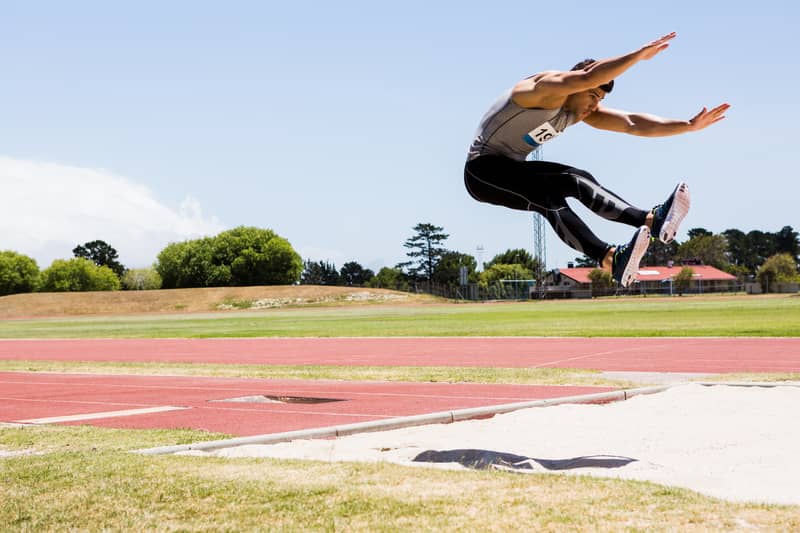Osteoarthritis is the most common type of arthritis. It is a degenerative disease that affects joints, causing pain, stiffness, and swelling. The symptoms typically develop over time, and the condition can worsen with age, significantly affecting the quality of life.
While there is no easy cure for osteoarthritis, there are treatment sessions like acupuncture points for knee osteoarthritis whose primary outcome is to manage the pain which will result in secondary outcomes like increased mobility and better quality of life.
Acupuncture is one such treatment that has been gaining popularity in recent years as part of Traditional Chinese Medicine. Studies have shown that a few treatment sessions of acupuncture for osteoarthritis can help to relieve chronic pain in the knee joint and improve function in patients with other types of musculoskeletal pain.
Human health is maintained by the smooth flow of the meridian, which is the path of internal energy, or “Qi”. If the Qi is blocked for some reason, it can cause illness, pain, and discomfort.
If a disorder appears in an organ, the symptoms are seen on the surface of the meridians that are closely related to the function of the organ.
Acupoint: SP-10 (Other Names: Spleen-10/Xue Hai/Sea of Blood)

The acupressure point “SP-10”, is represented in mandarin as “Xuehai” and in English as “Sea of Blood.” It can be located when the knee is bent, the point is 2 cun above the media superior border of the patella, on the bulge of the medial section of the quadriceps femoris muscle.

Acupoint SP-10 is one of the acupressure points for ovary cysts that energizes and pumps the blood, cools the blood, nourishes the skin, regulates menstruation, and aids in the treatment of urticaria, eczema, and erysipelas.
Press the SP-10 (Xuehai) point firmly with your fingertips for 1 minute to feel the obvious soreness, 3 to 5 times on each side.
In 2018, a clinical study was conducted to investigate the efficacy and safety of various types of acupuncture treatment for knee osteoarthritis, provide strong evidence, evaluate the feasibility and significance of traditional acupuncture and sham acupuncture study designs, and improve acupuncture and moxibustion standardization for knee osteoarthritis.
In this trial, acupoint SP-10, being one of the acupuncture points for knee osteoarthritis, was included in the mild moxibustion and sham acupuncture intervention groups. The various types of acupuncture treatment for knee osteoarthritis investigated in this type of randomized trial are commonly used in clinics, and sham acupuncture is frequently employed as control or placebo in the systematic review of high-quality clinical trials.
However, some previous studies have been conducted to confirm the efficacy of pain relief and safety of acupuncture therapy for knee osteoarthritis.
In 2014, clinical trials were conducted to compare the effects of acupressure against isometric exercise on chronic pain, stiffness, and physical function in female knee osteoarthritis patients. Acupressure was used on several acupoints, including SP-10.
Acupressure therapy in combination with isometric exercise was found to alleviate the symptoms of pain, stiffness, and physical function in female knee osteoarthritis patients.
Acupoint: ST-34 (Other Names: Stomach-34/Liang Qiu/Ridge Mound)
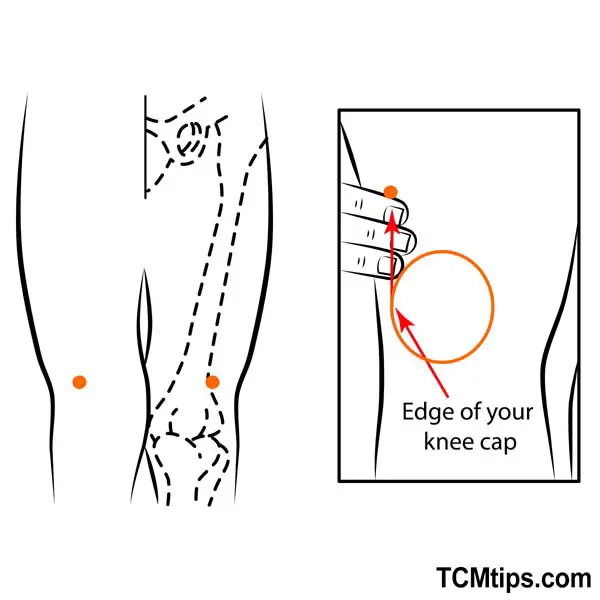
The acupressure point “ST-34”, is represented in mandarin as “Liangqiu” and in English as “Beam Mound.” It can be located when the knee is flexed, 2 cun above the patella, on the anterior face of the thigh, on the line connecting the anterior superior iliac spine, and the lower lateral border of the patella.
It is classified as the Xi-Cleft point of the Stomach Meridian. Harmonizes the Stomach and subdues rebellious Qi, activates the meridian, heals acute conditions, and reduces discomfort. ST-34 is one of the pressure points for thigh pain which is useful in conditions such as acute mastitis, acute gastric pain relief, knee joint swelling and pain, as well as paralysis or weakness of the lower extremities.
Press above the patella using the thumbs and index fingers of both hands, directing your pressure above the knee bone. This activates ST-34 and other unique knee acupoints. Lean your weight forward for 10 seconds to apply pressure.
Then, slowly release the pressure, rotate your fingertips one-quarter inch, and reapply it above your kneecap. Repeat this several times for two minutes to thoroughly press around your kneecap.
According to an Osteoarthritis Research Society International systematic study, patients with knee osteoarthritis may benefit from acupuncture treatment to lessen pain symptoms.
Clinical trials were conducted on the use of acupuncture to treat knee osteoarthritis patients awaiting arthroplasty surgery. ST-34 was one of several acupuncture points for knee osteoarthritis that were used. It was concluded that acupuncture could improve the management of osteoarthritis, help in physical therapy and potentially avoid surgery.
Acupoint: SP-9 (Other Names: Spleen-9/Yin Ling Quan/Yin Mound Spring)
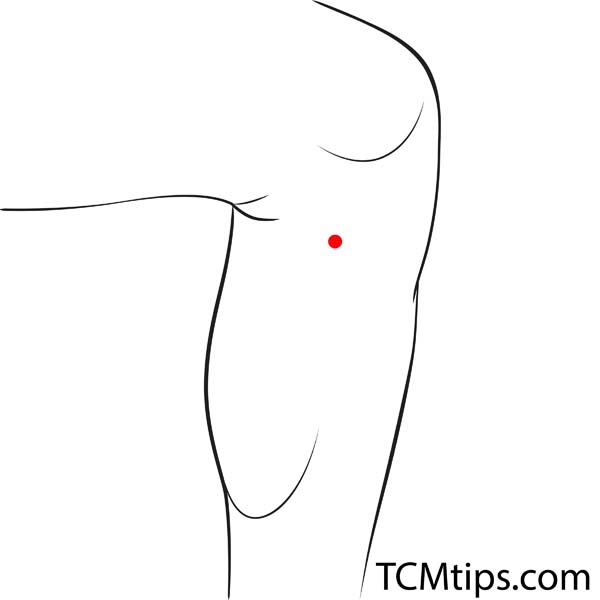
The acupressure point “SP-9”, is represented in mandarin as “Yinlingquan” and in English as “Yin Mound Spring.” It can be located in the depression of the lower border of the medial condyle of the tibia on the medial aspect of the lower leg.
This acupoint is classified as the He-Sea point of the Spleen Meridian. To apply acupressure at SP-9, press gently but firmly for 10-20 seconds, then release and repeat.
SP-9 is one of the acupuncture points for knee osteoarthritis that resolves dampness (particularly in the Lower Jiao), regulates the Spleen, and facilitates urination. This acupoint helps with:
– dysuria
– urinary incontinence
– edema, jaundice
– diarrhea
– abdominal distention
– knee pain in the medial aspect
– pain in the penis
– dysmenorrhea
– vulva pain
A randomized controlled trial was conducted to assess the effectiveness of acupuncture for knee osteoarthritis as a supplemental therapy to pharmaceutical treatment. SP-9 was one of the numerous acupoints chosen for the intervention in this investigation.
This trial concluded that acupuncture as a complementary therapy to the pharmacological treatment of knee osteoarthritis is more successful than pharmacological treatment alone in pain and stiffness reduction, physical functional improvement, and an improved quality of life.
Another randomized controlled trial examined the effect of manual and electroacupuncture on symptom alleviation in patients with knee osteoarthritis. This study concluded that using acupoints, including SP-9, manual, and electroacupuncture provides a considerable improvement in the symptoms of osteoarthritis of the knee, either on its own or as an additional therapy.
Acupoint: BL-40 (Other Names: Urinary Bladder-40/Wei Zhong/Middle of the Crook)
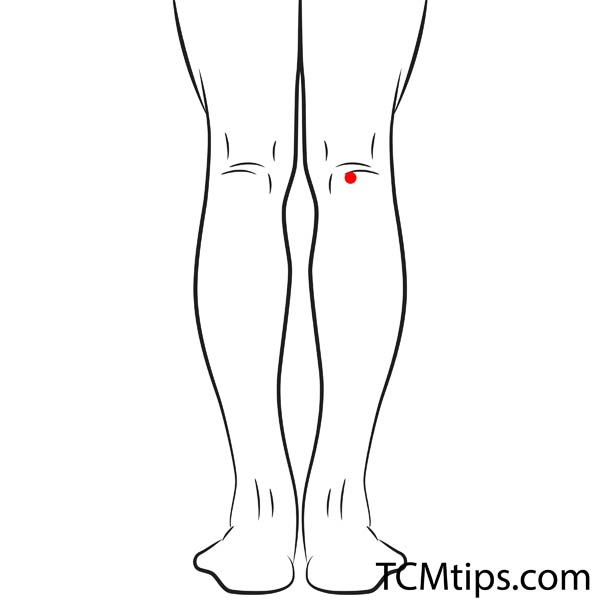
The acupressure point “BL-40”, is represented in mandarin as “Weizhong” and in English as “Supporting Middle.” It can be located at the midpoint of the popliteal fossa’s transverse crease, between the tendons of muscle biceps femoris and muscle semitendinosus.
Acupoint BL-40 is classified as the He-Sea point of the Urinary Bladder and Command Point of the low back. This acupoint Cools the Blood, clears Summer-Heat, activates the meridian, and soothes pain by clearing heat and resolving dampness.
The BL-40 is one of the acupressure points for pelvic pain that is beneficial in treating:
– lumbar discomfort
– spasms
– lower-extremity weakness
– back erysipelas
– rash
– general pruritus
– furuncle and carbuncle
– vomiting
– diarrhea
– abdominal pain
– dysuria
– enuresis
Acupoint BL-40 is commonly used as one of the effective acupuncture points for knee osteoarthritis as well as lower back pain.
Press BL-40 hard for 5 seconds while feeling soreness intensity, then release and repeat 5 times. Patting it can also be used, sitting on a chair with your right leg on your left leg, patting BL-40 with your palm many times, then changing 10 to 15 times in a turn.
Acupoint: EM-45 (Other Names: Xiyan/Inner Eye of the Knee)
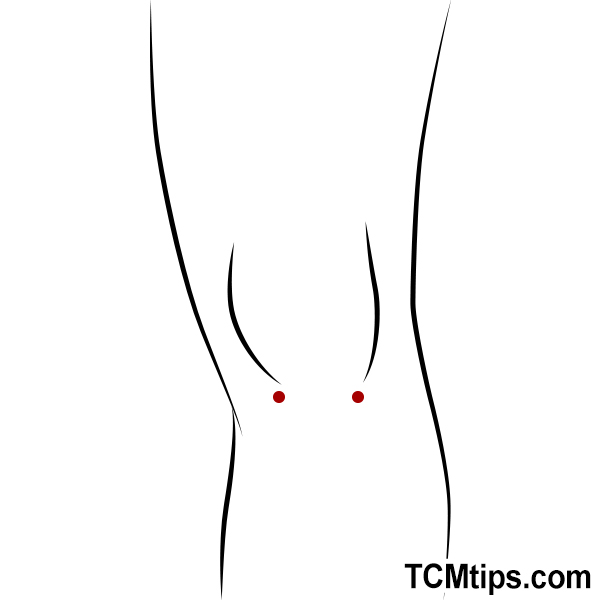
The acupressure point “EM-45”, is represented in mandarin as “Xiyan” and in English as “Eye of the Knee.” The acupoint EM-45 is located in the depression on both sides of the patellar ligament when the knee is flexed.
Wind-Dampness is removed, swelling is reduced, the knees are benefited, and discomfort is relieved by applying pressure at this acupoint. EM-45 is beneficial in treating knee pain and swelling as well as the weakness of the lower extremities in human bodies.
Knee osteoarthritis is sometimes known as ‘wear and tear’ arthritis. Physical damage to protective tissues occurs, which might result in joint abnormalities. Pain and limited range of motion in daily life are among the symptoms of knee osteoarthritis.
In a pilot study, acupoint EM-45 was used to assess the effects of acupuncture on chronic knee pain due to osteoarthritis. According to the findings of this pilot trial, the effectiveness of acupuncture as adjunctive therapy in the treatment of knee osteoarthritis in patients who have not responded to regular medical therapy was reported.
Related Articles
Pressure Point for Knee Pain – If you’ve found our guide on acupuncture points for knee osteoarthritis helpful, you’ll definitely want to check out our article on DIY acupressure points for knee pain. Learn simple, step-by-step techniques to manage knee pain at home, offering you another layer of self-care and control over your well-being.

Try our Anti-Aging Gua Sha Tool designed to bring out your skin’s natural glow.
Best Gua Sha Product- Anti-Aging: The tool is designed to target 11 specific aging signs such as wrinkles and sagging skin. By following the 7-step routine, users can improve skin firmness and reduce fine lines naturally.
- Enhances Skincare Routine: It works effectively with serums and lotions, boosting absorption and efficacy of skincare products.
- Visible Skin Improvement: Users can expect a smoother complexion, reduced puffiness, and a more youthful appearance.
 P. Sze
P. Sze 